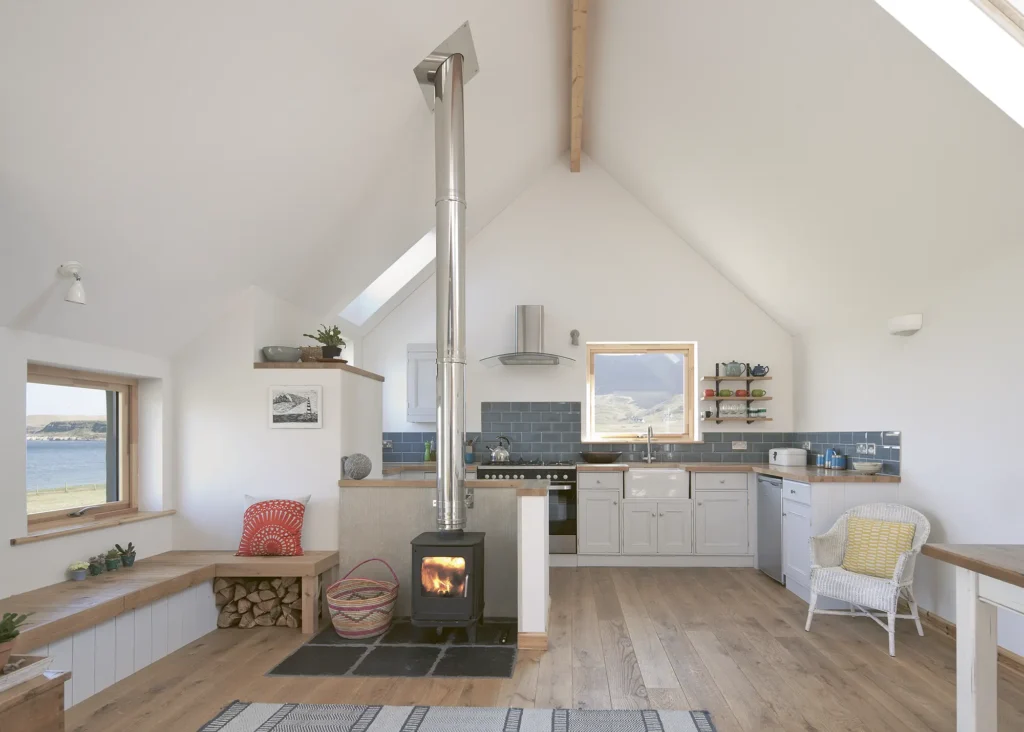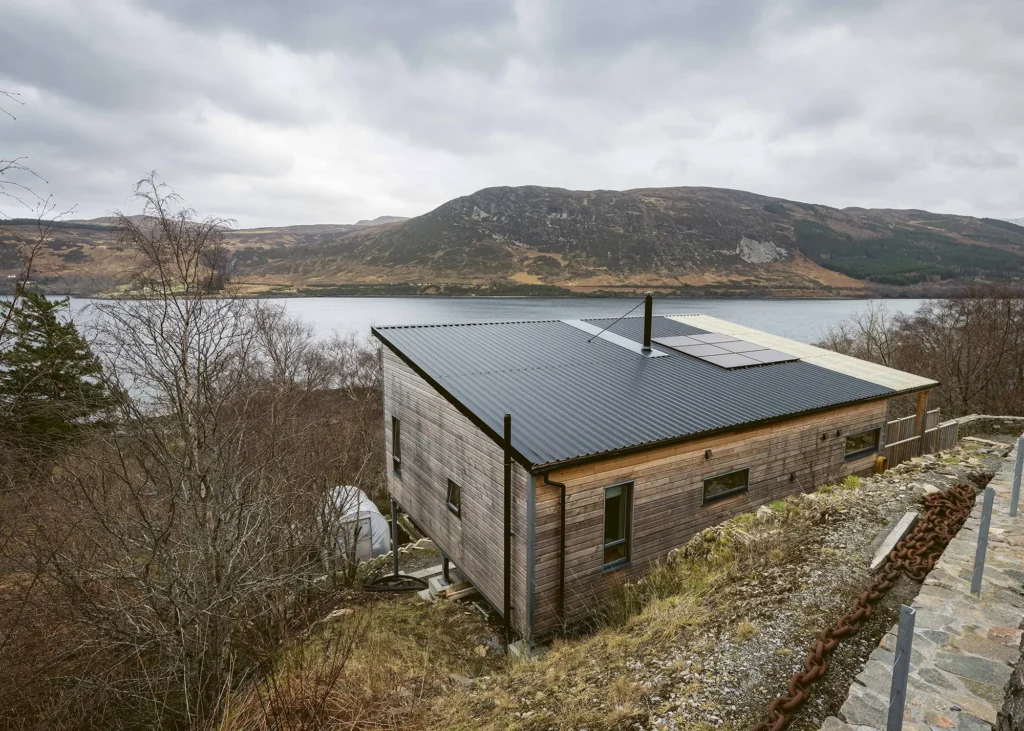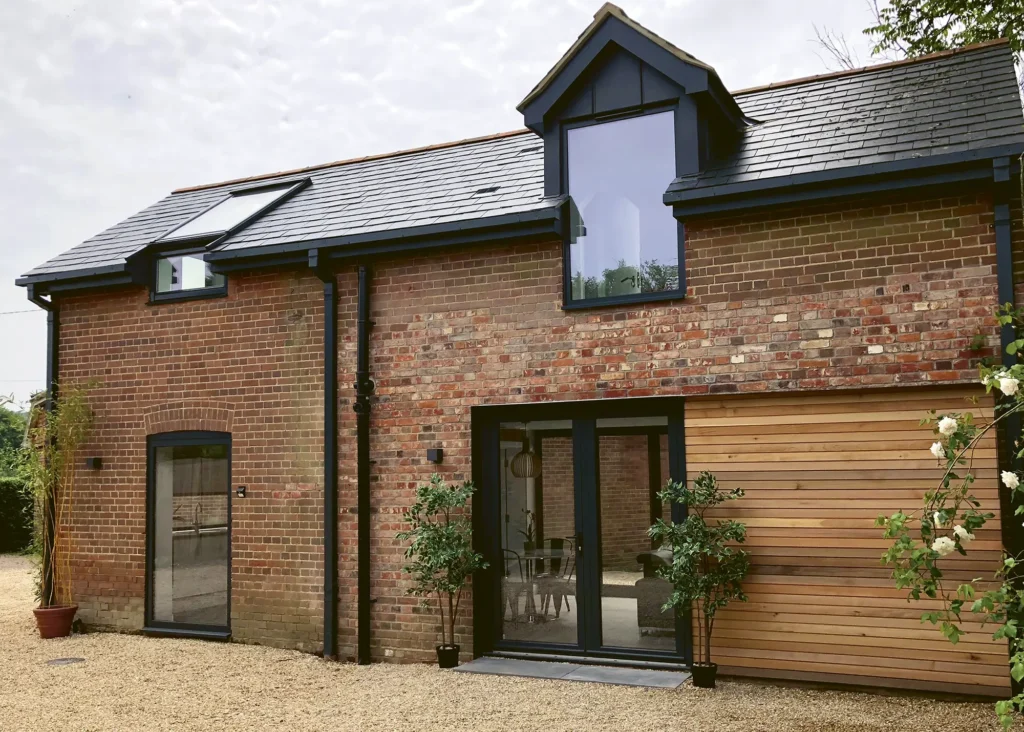

The most sustainable way to heat anything is not to have to heat it at all! Small eco homes built to levels of insulation and airtightness beyond the Building Regulations will have very low heat demand.
The warmth from people living in it – our bodies, our washing and cooking, plus the appliances we use – can be sufficient to heat many properties in all but the coldest weather. To some degree this also depends on the location – ie how exposed the house is and the amount of windows on the southern facade that can deliver solar gains in winter.
Even new homes simply built in accordance with the minimum requirements of the regs will have very low heat demand these days. So, the simple answer to the question of how to warm a small new home efficiently is that it doesn’t really matter, as the energy needed will not cost much and the impact on the environment will be minimal whatever fuel or system is chosen.
Existing, older houses will have a higher heat demand, so in this article we’ll explore all the heating options and note what is particularly applicable to new or to existing homes.
Before we look at the key system options, we need to first think about what it is exactly that we’re heating in our homes. We tend to focus our thoughts on energy use around heating the living spaces. But as houses (and appliances) have become more thermally efficient, the highest demand for energy could well come from the water we use for showering and bathing, known as domestic hot water (DHW).
So, when we consider the various options for heat sources, it’s important to bear in mind that DHW could be the most important heat use. This could have a big impact on our conclusions, because hot water must be delivered at a higher temperature than space heating.
Learn More: What Heating Should I Install In My Self Build House?

For Saira Renny and George Carr’s 50m2 eco home on the Isle of Eigg, a stylish woodburning stove takes centre stage in the living space. The couple also benefitted from a green grant from the Eigg Trust, which allowed them to install a solar thermal array. Photo: David Barbour
As many people are aware, there is a possibility that gas boilers will be phased out of new homes as part of the Future Homes Standard – although the suggested date for this has just been pushed back from 2025 to 2035. For existing homes with a gas supply, you’ll still be able to install replacement gas boilers.
Newly-built houses should have such low space heating demand that the environmental impact of keeping your home warm should be small, even if a gas boiler is used. It’s also worth noting that a boiler delivers water at high temperatures, so it’s well suited to fulfilling a hot water demand roughly between 60°C and 70°C.
For existing homes, the decision is more difficult. Poorly insulated properties with a relatively higher heat demand often need the kind of hot heat that a boiler supplies, to heat up fast enough to deliver thermal comfort.
CLOSER LOOK Embodied emissions & lifetime costsIf you’re thinking about upgrading your heating system, your key aim might be to reduce carbon emissions. For a small home, the impact of space and water heating in use should not be significant. But the carbon emissions of the fuel are not the only thing that matters. The emissions caused by the manufacture, delivery and installation of heating equipment are known as embodied emissions. When looking at a small home, the embodied impact of the heating equipment is relatively greater than for a large home (which uses much more fuel but with similar heating equipment). So, don’t be afraid to ask manufacturers for their statistics on embodied energy and carbon. Your key priority may be saving money. For a small home with low energy use, we need to consider the cost of purchasing and later replacing the heating equipment. For example, if fitting a boiler is £3,000 and it lasts 10 years, the annual cost of owning it would equate to £300, in addition to maintenance fees and the fuel itself. Heat pumps are more expensive to buy, at least twice the price. Running costs of heat pumps and gas boilers are currently similar, so the cost of ownership would be double that of gas if the expected life is the same. |
There are two common types of heat pump – ground source heat pumps (GSHPs) and air source heat pumps (ASHPs). For a home with low heat demand, the impact of installing ground collector loops would far outstrip any savings in use (although one exception is groups of small homes heated by a common ground loop, such as on social housing schemes). In small homes, air source heat pumps are the main option.
ASHPs work most efficiently when the temperature of the heat source (the air) is at its warmest. Properly designed and installed, however, they can still deliver good winter performance. They are not so efficient when it comes to delivering DHW, as the delivery temperature needs to be higher and stored water must be disinfected against Legionella. The difference in temperature between heat source and heat delivery is higher for hot water than for space heating, so the pump has to work harder and thus becomes less efficient.
Thanks to the rapid and impressive decarbonisation of the electricity supply in the UK, heat pumps now emit much less CO2 per kWh of heat delivered than gas or oil boilers. However, it’s important to check and include the embodied impact of the equipment itself, rather than making a decision based purely on carbon emissions.
For space heating, all heat pumps work most efficiently when paired with underfloor heating. Your small home may be one or two storeys but as heat rises, for new builds especially, a heat distribution system is not always needed on upper floors – often just a towel rail in the bathroom (if that’s upstairs).
Essential Heat Pump Advice: Heat Pump Guide: What Are Heat Pumps & How Do They Work?

The low pitch of Alice and Moz Mikietyn’s 70m2 property in the Scottish Highlands is perfect for the solar thermal panels, which power the domestic hot water (DHW). The only space heating source is a stove in the living room. Photo: John Paul
A modest woodburning stove may be quite sufficient to provide all the space heating needs in a small home. Best of all, this heating system is as near to zero carbon as you can get, especially if the firewood is locally sourced and/or waste wood.
In a small home, heat distribution is not normally an issue, as the warmth dissipates well from a central heat source. The other advantage of single point heating is that, if you’re too hot, you move away from the fire. Too cool and you can get closer. It’s radiant energy and is how we would have experienced heat in former times (rather than the modern way of looking at air temperatures).
Self builders sometimes come to see me at the Build It Live shows with plans to live off-grid in a small eco home. Often there is firewood available on or near the land where they are planning to build, which makes it genuinely sustainable in every way.
These folk are always a delight to meet and I have great respect for their vision, which tends to encompass wider lifestyle choices than just low carbon heating. Often, they will be cooking off the same stove, and there are some great combination cooking/heating stoves on the market.

In their 80m2 coach house renovation in Hampshire, George and Rebekah Burn opted for five electrically-powered radiators to keep the property warm, which were affordable to install. The huge amount of insulation that’s been packed into the house makes for a minimal heat demand, ensuring low running costs. The project was designed by LA Hally Architect
DHW can also be provided by stoves, via a heat exchanger linked to a hot water storage vessel. The only consideration here is that there will be times when you need hot water, but you don’t need (or want) to light the fire and produce space heat, as the weather is already warm enough. The solution to this is to have a secondary link from your hot water storage system to a solarwater heater. This way, most of the time either it’s cold and you have the fire on, or it’s hot outside and the solar water heater does the DHW job for free.
For larger homes, pellet boilers would be needed rather than stoves, as they will feed an emitter distribution system – usually underfloor heating. It’s unlikely that you could justify the expense of purchasing and installing a pellet boiler in a large home. But for some existing houses where the potential for retrofit insulation is limited, a pellet boiler would be an excellent way to reduce emissions in use, as long as it’s permitted in your area.
Read More: Woodburning Stoves: Your Guide to Choosing & Installing Woodburners
Solar thermal panels can provide DHW for up to 50% of the year and an array can do useful work even on warm cloudy days. Compared to other zero carbon technologies, they are relatively inexpensive.
As DHW has become a larger component of heat demand, and perhaps the largest for eco homes, fitting a solar water heater should be a no-brainer. Of course, the decision isn’t quite as clear cut as this, especially for existing homes. Whatever the main heat source (gas, biomass, heat pump) a secondary coil is required in the DHW cylinder, which increases the system cost.
For new builds, the price of a cylinder is already factored in and the additional cost is only for specifying one with the extra coil. You will also have easy access to the roof (for mounting and pipework) while the house is being built, so the marginal costs of installation should be relatively low. On that basis, if you’re building a new home and have a suitable southerly roof elevation, you should always at least consider installing a solar water heater.
The great advantage of pure hydrogen boilers is that they emit no CO2 at the point of use (hydrogen when combined with oxygen simply produces H2O; water). The key question, from the point of view of sustainability, thus becomes how the hydrogen is produced.
Pure hydrogen boilers are not yet in common use and there are no pure hydrogen networks, so they’re not really an option for self builders. Hydrogen is instead most likely to become a key method of decarbonising the gas grid.
Trials are already underway in some areas, where 20% hydrogen is being introduced into the gas supply. Most boilers can already use this hydrogen with no alterations. Others are hydrogen-ready, so they operate on natural gas now but can be simply, cheaply and quickly converted to run on 100% hydrogen if it’s widely adopted in future.
Looking for heating technology for your new self build home? Browse Build It’s Product Directory full of high-quality options
